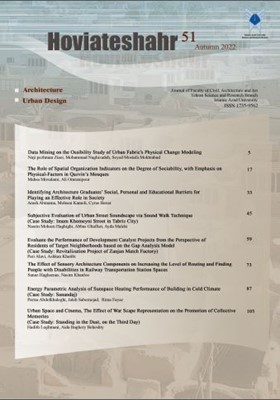Identifying architecture graduates’ social, personal and educational barriers for playing an effective role in society
Subject Areas : architecturearash abinama 1 , mohsen kameli 2 * , cyrus bavar 3
1 - architecture department, Faculty of engineering, Islamic azad university, Saveh, Iran
2 - architecture department, Faculty of engineering, Islamic azad university, Saveh, Iran
3 - architecture department, Faculty of engineering, Islamic azad university, Saveh, Iran
Keywords: individual barriers, social barriers, Architecture training, Architecture graduates,
Abstract :
University, a source of science production, can play an important role in the development of society in economic, social, cultural, and political dimensions. If universities and training centers do not succeed in this endeavor, a gap between what students learn and the needs of the professional environment will emerge. Also, playing the effective role of architects in society is an essential issue. However, architecture graduates do not have a proper perspective of their professional future, and despite their theoretical knowledge, they face many obstacles in society. We are now in an age where we are witnessing drastic changes in the labor market. This deprives the persons’ job security, assurance, and expands the range of skills that he needs to learn in order to enter the professional environment. To promote Iranian architecture education, efforts have been made by researchers in the form of histories and reviews of curriculum units, but it is not reviewed to know what are the barriers ahead graduates to play an effective, and professional role. Therefore, investigating, in this case, is very important and necessary for entrepreneurship, skills training, and the development of cooperation between universities, industry, and the promotion of architectural education. This article identifies the barriers and related important parameters. It tries to identify the educational problems, difficulties, and development of teachers’ education, more effective educational programs and promoting students' learning to adapt to the professional environment in society. In this research, a combination of qualitative and quantitative research methods has been used. Therefore, using the method of analytical-exploratory research deals with this issue. First, using the Delphi method and qualitative analysis by MAXQDA, a questionnaire was prepared for surveying architecture graduates and specialists, and 384 people were selected as the sample of this study by Cochran test. Then the answers to the questionnaire were quantitatively analyzed using factor analysis by SPSS and parallel analysis. Findings show that after the final rotation of research indices by the Varimax method, correlated indices were placed in all three categories. The first category includes items Q5, Q18, and Q8 with a factor loading of 0.804, -0.736, 0.498, and the second category includes items Q12, Q4, and Q17 with a factor loading of 0.735, 0.732, 456. The third category includes items, Q3, Q11, Q9, and Q16 with a factor loading of 0.606, 0.602, -0.510, -0.444. The names of educational and skill barriers, social and cultural barriers, individual and psychological barriers, were selected for the factors, after interpreting the nature of the related indicators. Finally, it is found that these three barriers are ahead of architecture graduates and their important factors are: lack of practical training and soft skills, lack of proper business model, and credentialism. Research and presentation of various solutions in the field of all indicators of the three barriers, especially the final indicators, is very important and can be the issue of starting future research and can be used by major policymakers of higher education, architecture researchers, university professors, students, and Entrepreneurs.
_||_

